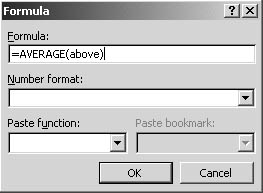Working with Functions in Tables
3 4
Although Word is happy to leave the truly complicated calculations to its suite-sister, Excel, the program includes support for working with a number of functions in your tables. Some of the Word tables you create will no doubt include numbers—and some of those columns will require totals, averages, and more.
Adding with AutoSum
The function you'll use most often will probably be AutoSum, included as a button on the Tables And Borders toolbar. AutoSum will total the cell values in contiguous cells in a column or row. To use AutoSum, follow these steps:
- Click in the cell at the end of a column of numbers (or the right end of a row).
- Click the AutoSum button on the Tables And Borders toolbar. Word automatically totals the column or row of numbers and inserts the total at the insertion point.
Note
Whenever you change a value in the column used to create the AutoSum total, the change will be reflected in the sum. To force an update of calculations in your table, press F9.
Using Other Functions
AutoSum isn't the only function you can include in your Word tables. You can create a number of calculations, depending on what you want the data in your tables to do. You can create your own formulas and work with other Word functions by using the Formula dialog box shown in Figure 18-20.

Figure 18-20. You can create your own formulas in the Formula dialog box.
You can display the different functions Word allows by clicking the Paste Function down arrow. These functions are available for your selection:
ABS | IF | OR |
AND | INT | PRODUCT |
AVERAGE | MAX | ROUND |
COUNT | MIN | SIGN |
DEFINED | MOD | SUM |
FALSE | NOT | TRUE |
To insert your own formula in a table, follow these steps:
- Click in a cell at the end of a column of numbers where you want to add the formula.
- Choose Table, Formula. The Formula dialog box is displayed.
- Type = in the Formula box to tell Word you're entering a formula.
- Click the Paste function down arrow and choose the function you want from the displayed list. (For this example, AVERAGE was selected.) The function is added to the Formula box, and parentheses are supplied.
- Type ABOVE within the Parenthesis as shown in Figure 18-20. This tells Word to gather the average value of all items listed in the column above the current cell.
- Click OK to close the Formula dialog box. Word calculates the answer and displays it in the table cell.
Tip - Choose a number format
You can have Word display a numeric result in the format you want. Simply click the Number Format down arrow and choose from the displayed options.
EAN: 2147483647
Pages: 337